
Wetenschap
China plant nieuwe kolencentrales, snijdt steun voor schone energie af

In deze 27 november, 2019, foto, een installatie van zonnepanelen is te zien in Ruicheng County in de provincie Shanxi in het centrum van China. Terwijl wereldleiders in Madrid samenkomen om te bespreken hoe we de opwarming van de aarde kunnen vertragen, een schijnwerper valt op China, de grootste uitstoter van broeikasgassen. China verbrandt jaarlijks ongeveer de helft van de kolen die wereldwijd worden gebruikt. Toch is het ook de leidende markt voor zonnepanelen, windturbines en elektrische voertuigen. (AP Foto/Sam McNeil)
Terwijl wereldleiders in Spanje samenkomen om te bespreken hoe we de opwarming van de aarde kunnen vertragen, een schijnwerper valt op China - de grootste uitstoter van broeikasgassen.
China verbrandt jaarlijks ongeveer de helft van de kolen die wereldwijd worden gebruikt. Tussen 2000 en 2018, de jaarlijkse CO2-uitstoot bijna verdrievoudigd, en het is nu goed voor ongeveer 30% van het wereldtotaal. Toch is het ook de leidende markt voor zonnepanelen, windturbines en elektrische voertuigen, en het produceert ongeveer tweederde van de zonnecellen die wereldwijd zijn geïnstalleerd.
"We zijn getuige van veel tegenstrijdigheden in de energieontwikkeling van China, " zei Kevin Tu, een in Peking gevestigde fellow bij het Center on Global Energy Policy aan de Columbia University. "Het is de grootste kolenmarkt en de grootste markt voor schone energie ter wereld."
Die schijnbare paradox is mogelijk vanwege de enorme omvang van China's energiebehoefte.
Maar aangezien de Chinese economie vertraagt tot het laagste niveau in een kwart eeuw – ongeveer 6% groei, volgens overheidsstatistieken - beleidsmakers verdubbelen hun steun voor steenkool en andere zware industrieën, de traditionele ruggengraat van het energiesysteem en de economie van China. Tegelijkertijd, het land verlaagt subsidies voor hernieuwbare energie.
Op de jaarlijkse klimaattop van de Verenigde Naties dit jaar in Madrid, regeringsvertegenwoordigers zullen de laatste hand leggen aan de uitvoering van de Overeenkomst van Parijs van 2015, die zich tot doel stelden om de toekomstige opwarming te beperken tot 1,5 tot 2 graden Celsius boven het pre-industriële niveau. Naties mogen zelf beslissen hoe ze dit willen bereiken.

In deze 28 november, 2019, foto, een installatie van zonnepanelen is te zien in Ruicheng County in de provincie Shanxi in het centrum van China. Terwijl wereldleiders in Madrid samenkomen om te bespreken hoe we de opwarming van de aarde kunnen vertragen, een schijnwerper valt op China, de grootste uitstoter van broeikasgassen. China verbrandt jaarlijks ongeveer de helft van de kolen die wereldwijd worden gebruikt. Toch is het ook de leidende markt voor zonnepanelen, windturbines en elektrische voertuigen. (AP Foto/Sam McNeil)
China had eerder toegezegd zijn energiemix te verschuiven naar 20% hernieuwbare energiebronnen, inclusief kernenergie en waterkracht. Klimaatexperts zijn het er over het algemeen over eens dat de aanvankelijke doelstellingen die in Parijs zijn toegezegd niet voldoende zullen zijn om het doel te bereiken, en volgend jaar moeten landen ambitieuzere doelen formuleren.
De hoop dat China zou aanbieden om nog veel meer te doen, vervaagt.
Recente mediaberichten en satellietbeelden suggereren dat China nieuwe kolencentrales bouwt of van plan is deze te voltooien met een totale capaciteit van 148 gigawatt - bijna gelijk aan de volledige kolencentralecapaciteit van de Europese Unie in de komende jaren, volgens een analyse van Global Energy Monitor, een in San Francisco gevestigde non-profitorganisatie.
Afzonderlijk, investeringen in Chinese hernieuwbare energie daalden in de eerste helft van 2019 met bijna 40 procent vergeleken met dezelfde periode vorig jaar, volgens Bloomberg New Energy Finance, een onderzoeksorganisatie. De overheid heeft de subsidies voor zonne-energie verlaagd.

In deze 27 november, 2019, foto, een installatie van zonnepanelen is te zien in Ruicheng County in de provincie Shanxi in het centrum van China. Terwijl wereldleiders in Madrid samenkomen om te bespreken hoe we de opwarming van de aarde kunnen vertragen, een schijnwerper valt op China, de grootste uitstoter van broeikasgassen. China verbrandt jaarlijks ongeveer de helft van de kolen die wereldwijd worden gebruikt. Toch is het ook de leidende markt voor zonnepanelen, windturbines en elektrische voertuigen. (AP Foto/Sam McNeil)
Vorige week in Peking, China's viceminister van ecologie en milieu vertelde verslaggevers dat niet-fossiele brandstoffen al goed zijn voor 14,3% van de energiemix van het land. Hij gaf niet aan dat China binnenkort strengere doelen zou omarmen.
"We worden nog steeds geconfronteerd met uitdagingen bij het ontwikkelen van onze economie, het levensonderhoud van mensen verbeteren, ' zei Zhao Yingmin.
China wordt afwisselend gecast als 's werelds ergste klimaatschurk of zijn potentiële redder van schone energie, maar beide superlatieven zijn enigszins misplaatst.
Als snelgroeiende economie, het was altijd onvermijdelijk dat de vraag naar energie in China sterk zou stijgen. De enige vraag was of het land een voldoende groot deel van zijn economie kon voorzien van hernieuwbare energiebronnen om de emissiegroei te beteugelen.
Veel waarnemers putten hoop uit een korte daling van de CO2-uitstoot van China tussen 2014 en 2016, evenals de verklaring van de Chinese leider Xi Jinping in 2017 dat China "het voortouw had genomen in de internationale samenwerking om te reageren op klimaatverandering".

In deze 28 november, 2019, foto, een installatie van zonnepanelen is te zien in Ruicheng County in de provincie Shanxi in het centrum van China. Terwijl wereldleiders in Madrid samenkomen om te bespreken hoe we de opwarming van de aarde kunnen vertragen, een schijnwerper valt op China, de grootste uitstoter van broeikasgassen. China verbrandt jaarlijks ongeveer de helft van de kolen die wereldwijd worden gebruikt. Toch is het ook de leidende markt voor zonnepanelen, windturbines en elektrische voertuigen. (AP Foto/Sam McNeil)
Vandaag komt de hernieuwde focus van het land op steenkool als een teleurstelling.
"Nu is er een gevoel dat in plaats van een leider te zijn, China is degene die uit de pas loopt, " zei Lauri Myllyvirta, hoofdanalist bij het Centrum voor Onderzoek naar Energie en Schone Lucht in Helsinki. Hij merkt op dat verschillende ontwikkelde landen, waaronder Duitsland, Zuid-Korea en de Verenigde Staten verminderen snel hun afhankelijkheid van steenkool.
Fossiele brandstoffen zoals steenkool, benzine en aardgas geven kooldioxide af in de atmosfeer, warmte vasthouden en het klimaat veranderen. Steenkool is de grootste boosdoener.
Vorig jaar, het kolenverbruik in de Verenigde Staten bereikte het laagste niveau in bijna 40 jaar, volgens de Amerikaanse Energy Information Administration.
Een plek om de opkomst te overwegen, pauzeren en weer opstaan van de Chinese kolensector is de provincie Shanxi - een uitgestrekt bergachtig gebied in centraal China.
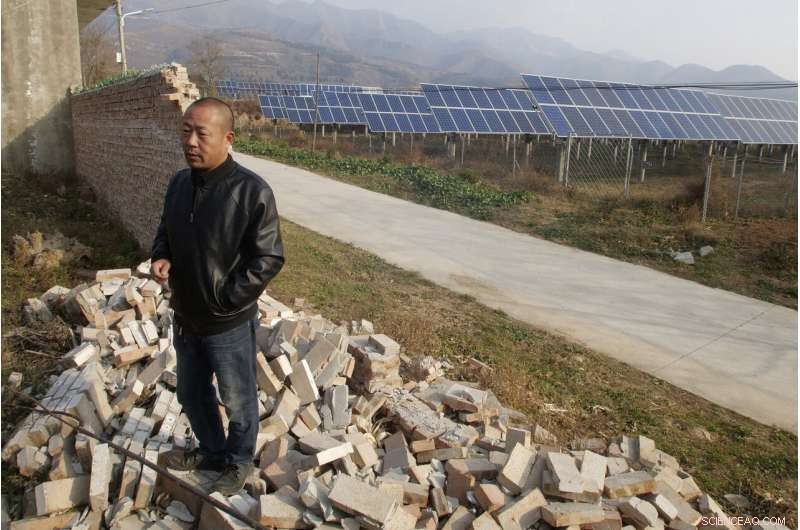
In this Nov. 28, 2019, foto, Chan Shicun, a construction materials trader, points to a wall he said local authorities destroyed after a disagreement with a massive government-backed solar project in Ruicheng County in central China's Shanxi Province. As world leaders gather in Madrid to discuss how to slow the warming of the planet, a spotlight is falling on China, the top emitter of greenhouse gases. China burns about half the coal used globally each year. Yet it's also the leading market for solar panels, wind turbines and electric vehicles. (AP Foto/Sam McNeil)
Shanxi is the heart of China's traditional coal country, dotted with large mines, but also the site of some of the country's largest solar and wind-power projects, according to state media.
During most of the past 30 years of rapid economic growth, the coal business boomed in Shanxi and nearby provinces. As China's cities and industries expanded, coal supplied much of that power, and China surpassed the U.S. as the world's top carbon emitter in 2006.
But after climbing sharply for two decades, China's emissions stalled around 2013 and then declined slightly in 2015 and 2016, according to Global Carbon Budget, which tracks emissions worldwide. This dip came as Chinese leaders declared a "war on pollution" and suspended the construction of dozens of planned coal power plants, including some in Shanxi.
Tegelijkertijd, the government required many existing coal operators to install new equipment in smokestacks to remove sulfur dioxide, nitrous oxide and other hazardous substances. About 80% of coal plants now have scrubbers, said Alvin Lin, Beijing-based China climate and energy policy director for the Natural Resources Defense Council, a nonprofit.
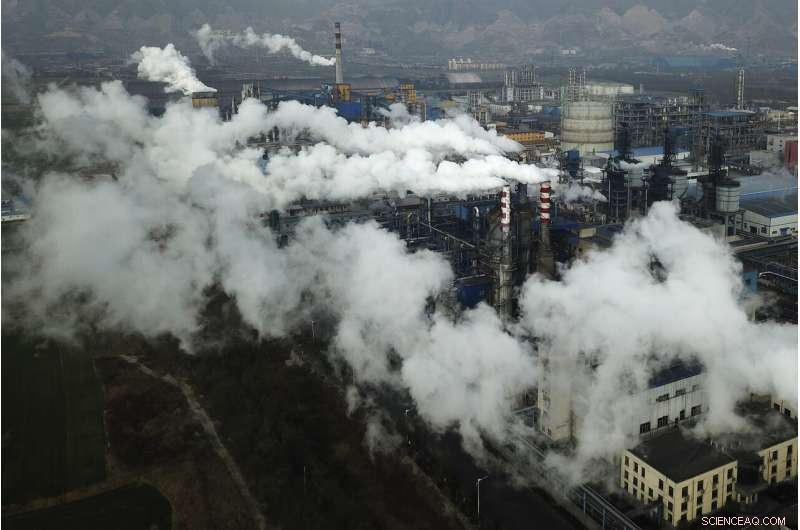
In this Nov. 28, 2019, foto, smoke and steam rise from a coal processing plant that produces carbon black, an ingredient in steel manufacturing, in Hejin in central China's Shanxi Province. As world leaders gather in Madrid to discuss how to slow the warming of the planet, a spotlight is falling on China, the top emitter of greenhouse gases. China burns about half the coal used globally each year. Yet it's also the leading market for solar panels, wind turbines and electric vehicles. (AP Foto/Sam McNeil)
Als resultaat, the air quality in many Chinese cities, including Beijing, improved significantly between 2013 and 2017. Residents long accustomed to wearing face masks and running home air-filter machines enjoyed a reprieve of more "blue sky days, " as low-pollution days are known in China.
Annual levels of PM 2.5—a tiny but dangerous pollutant—dropped by roughly a third across China between 2013 and 2017, from 61.8 to 42 micrograms per cubic meter, according to scientists at Beijing's Tsinghua University and other institutions. They made the report in November in the Proceedings van de National Academy of Sciences , a peer-reviewed journal.
"That's a big improvement, although in terms of safe air quality, we're still not there yet, " Lin said. China's pollution levels are still well above standards set by the World Health Organization.
While these retrofitted coal plants emit fewer pollutants that harm human health, the scrubbers do not reduce greenhouse gases. "The new plants are good for air quality, but you still have all that carbon dioxide that goes into the atmosphere, ' zei Lin.

In this Nov. 28, 2019, foto, a coal storage facility is seen in Hejin in central China's Shanxi Province. As world leaders gather in Madrid to discuss how to slow the warming of the planet, a spotlight is falling on China, the top emitter of greenhouse gases. China burns about half the coal used globally each year. Yet it's also the leading market for solar panels, wind turbines and electric vehicles. (AP Foto/Sam McNeil)
In the past three years, China's carbon emissions have begun to rise again, according to Global Carbon Budget.
That trend was evident in the first half of 2019, when China's carbon emissions from fossil fuels and concrete production rose 4%, compared with the same period last year, according to Myllyvirta's preliminary analysis of Chinese government data.
The coming winter in Beijing may see a return of prolonged smog, as authorities loosen environmental controls on heavy industry—in part to compensate for other slowing sectors in the economy. Cement and steel production remain both energy intensive and heavily polluting.
Permits for new coal plants proliferated after regulatory authority was briefly devolved from Beijing to provincial governments, which see construction projects and coal operations as boosts to local economies and tax bases, said Ted Nace, executive director of Global Energy Monitor.

In this Nov. 28, 2019, foto, a solar panel installation is seen in Ruicheng County in central China's Shanxi Province. As world leaders gather in Madrid to discuss how to slow the warming of the planet, a spotlight is falling on China, the top emitter of greenhouse gases. China burns about half the coal used globally each year. Yet it's also the leading market for solar panels, wind turbines and electric vehicles. (AP Foto/Sam McNeil)
"It's as though a boa constructor swallowed a giraffe, and now we're watching that bulge move through the system, " said Nace. In China, it takes about three years to build a coal plant.
In november, Premier Li Keqiang gave a speech to policymakers emphasizing the importance of domestic coal to energy security.
But because China's coal-power expansion is growing faster than energy demand, overcapacity "is a serious concern now, " said Columbia University's Tu.
And once new infrastructure is built, it's hard to ignore.
"It will be politically difficult to tear down a brand-new coal plant that's employing people and supporting a mining operation. It will make it more difficult for China to transition away from coal, " Nace said.
The world has already warmed by 1 degree Celsius. All scenarios envisioned by the Intergovernmental Panel on Climate Change for holding planetary warming to around 1.5 degrees Celsius involve steep worldwide reductions in coal-power generation.
-
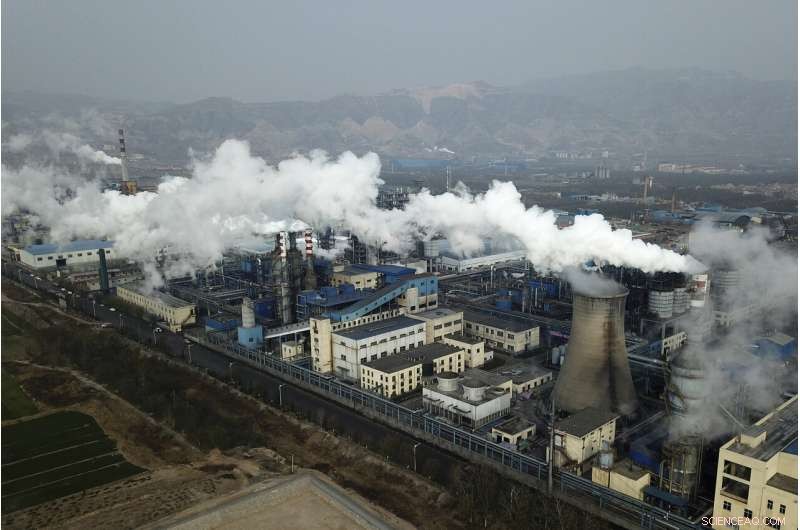
In this Nov. 28, 2019, foto, smoke and steam rise from a coal processing plant that produces carbon black, an ingredient in steel manufacturing, in Hejin in central China's Shanxi Province. As world leaders gather in Madrid to discuss how to slow the warming of the planet, a spotlight is falling on China, the top emitter of greenhouse gases. China burns about half the coal used globally each year. Yet it's also the leading market for solar panels, wind turbines and electric vehicles. (AP Foto/Sam McNeil)
-
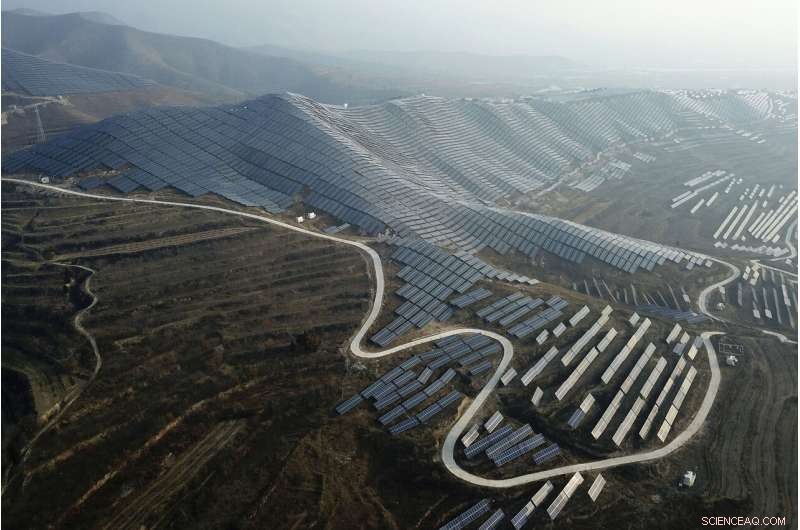
In this Nov. 28, 2019, foto, a solar panel installation is seen in Ruicheng County in central China's Shanxi Province. As world leaders gather in Madrid to discuss how to slow the warming of the planet, a spotlight is falling on China, the top emitter of greenhouse gases. China burns about half the coal used globally each year. Yet it's also the leading market for solar panels, wind turbines and electric vehicles. (AP Foto/Sam McNeil)
-
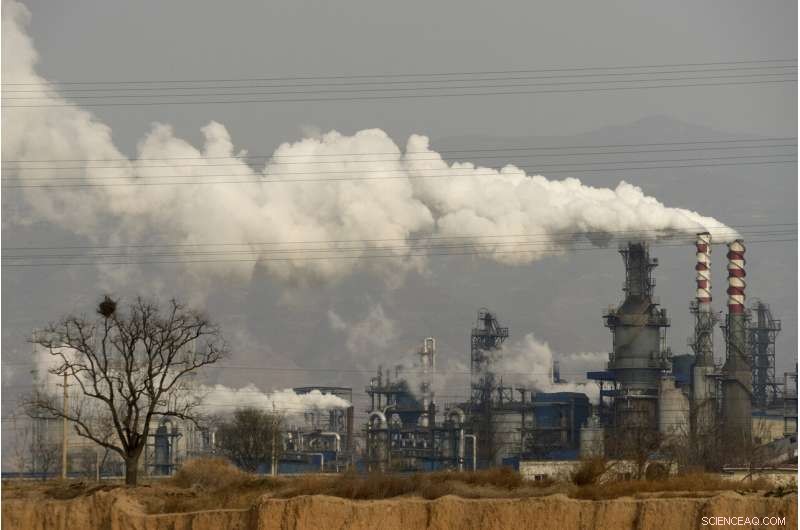
In this Nov. 28, 2019, foto, smoke and steam rise from a coal processing plant that produces carbon black, an ingredient in steel manufacturing, in Hejin in central China's Shanxi Province. As world leaders gather in Madrid to discuss how to slow the warming of the planet, a spotlight is falling on China, the top emitter of greenhouse gases. China burns about half the coal used globally each year. Yet it's also the leading market for solar panels, wind turbines and electric vehicles. (AP Photo/Olivia Zhang)
In that effort, other countries rely on China to manufacture most of the solar panels installed worldwide, according to an analysis in the journal Wetenschap co-authored by Jonas Nahm, an energy expert at Johns Hopkins University.
"If we have any chance to meet climate targets, we have to do a lot by 2030—and we won't be able to do it without China's clean-energy supply chain, " Nahm said.
China's manufacturing helped bring down the cost of solar panels by 80% between 2008 and 2013. Prices for wind turbines and lithium-ion batteries also dropped significantly, according to Bloomberg New Energy Finance.
"China has a really mixed record. On the one hand, it's seen rapidly rising emissions over the past two decades, " Nahm said. "On the other hand, it's shown it's able to innovate around manufacturing—and make new energy technologies available at scale, faster and cheaper."
© 2019 The Associated Press. Alle rechten voorbehouden.
 Ongebruikelijke biosynthetische route biedt een sleutel tot toekomstige ontdekking van natuurlijke producten
Ongebruikelijke biosynthetische route biedt een sleutel tot toekomstige ontdekking van natuurlijke producten Water beïnvloedt de plakkerigheid van hyaluronan
Water beïnvloedt de plakkerigheid van hyaluronan Intuïtie en falen zijn waardevolle ingrediënten in de chemie
Intuïtie en falen zijn waardevolle ingrediënten in de chemie Nieuwe interactie tussen dunne-filmmagneten voor snellere geheugenapparaten
Nieuwe interactie tussen dunne-filmmagneten voor snellere geheugenapparaten Hoe biobrandstof te maken van maïs
Hoe biobrandstof te maken van maïs
 Alarmerend lage regenniveaus zorgen ervoor dat Californië in de zomer brandgevaarlijk is, val
Alarmerend lage regenniveaus zorgen ervoor dat Californië in de zomer brandgevaarlijk is, val Afghanistan heeft enorme minerale rijkdom, maar staat voor grote uitdagingen om deze aan te boren
Afghanistan heeft enorme minerale rijkdom, maar staat voor grote uitdagingen om deze aan te boren Levenscyclus van een cricket
Levenscyclus van een cricket Hoe werkt een GPS-zender bij het bestuderen van plaatbewegingen?
Hoe werkt een GPS-zender bij het bestuderen van plaatbewegingen?  Wie moet betalen voor schade die verband houdt met klimaatverandering - en wie moet worden vergoed?
Wie moet betalen voor schade die verband houdt met klimaatverandering - en wie moet worden vergoed?
Hoofdlijnen
- Tropische diversiteit wortelt in relaties tussen schimmels en zaden
- Kenmerken van micro-organismen
- De verschillen tussen Catecholamines en Cortisol
- Hoe soorten versteend hout te identificeren
- Door het uitbreiden van het DNA-alfabet kunnen cellen nieuwe eiwitten produceren
- Migratie loont voor zangvogels
- Biofysici ontrafelen de exacte vouwing van een enkel gen
- Gezondheidsonderzoekers visualiseren een leven in silico
- 3 Eigenschappen van een cel
- Microscopische planten in de oceanen - diatomeeën - vangen koolstofdioxide op via biofysische paden

- Alaska Natives en vissers klagen EPA aan voor het terugdraaien van de beslissing van de Pebble Mine

- Hoe wordt kooldioxide geabsorbeerd tijdens fotosynthese?

- Duitse overstromingsrisico's waren duidelijk onderschat

- Wetenschappers identificeren de meest urgente problemen van chemicaliën in het milieu

 Herstel van land essentieel om te overleven:succesvol herstel van droog land ten gunste van twee miljard mensen
Herstel van land essentieel om te overleven:succesvol herstel van droog land ten gunste van twee miljard mensen Wetenschappers vinden ontbrekende aanwijzing over hoe hiv cellen hackt om zichzelf te verspreiden
Wetenschappers vinden ontbrekende aanwijzing over hoe hiv cellen hackt om zichzelf te verspreiden Spanningsregelaar: Theory of Operation
Spanningsregelaar: Theory of Operation ATLAS Experiment onderzoekt hoe het Higgs-deeltje interageert met andere bosonen
ATLAS Experiment onderzoekt hoe het Higgs-deeltje interageert met andere bosonen CERN:Studie werpt licht op een van de grootste mysteries van de natuurkunde:waarom er meer materie is dan antimaterie
CERN:Studie werpt licht op een van de grootste mysteries van de natuurkunde:waarom er meer materie is dan antimaterie HvJ zegt dat Frankrijk Airbnb niet kan laten registreren als makelaar
HvJ zegt dat Frankrijk Airbnb niet kan laten registreren als makelaar Koolstofetikettering kan broeikasgassen verminderen, zelfs als het het consumentengedrag niet verandert
Koolstofetikettering kan broeikasgassen verminderen, zelfs als het het consumentengedrag niet verandert Bootverkeer bedreigt het voortbestaan van de Bocas Del Toro-dolfijnen in Panama
Bootverkeer bedreigt het voortbestaan van de Bocas Del Toro-dolfijnen in Panama
- Elektronica
- Biologie
- Zonsverduistering
- Wiskunde
- French | Italian | Spanish | Portuguese | Swedish | German | Dutch | Danish | Norway |

-
Wetenschap © https://nl.scienceaq.com

